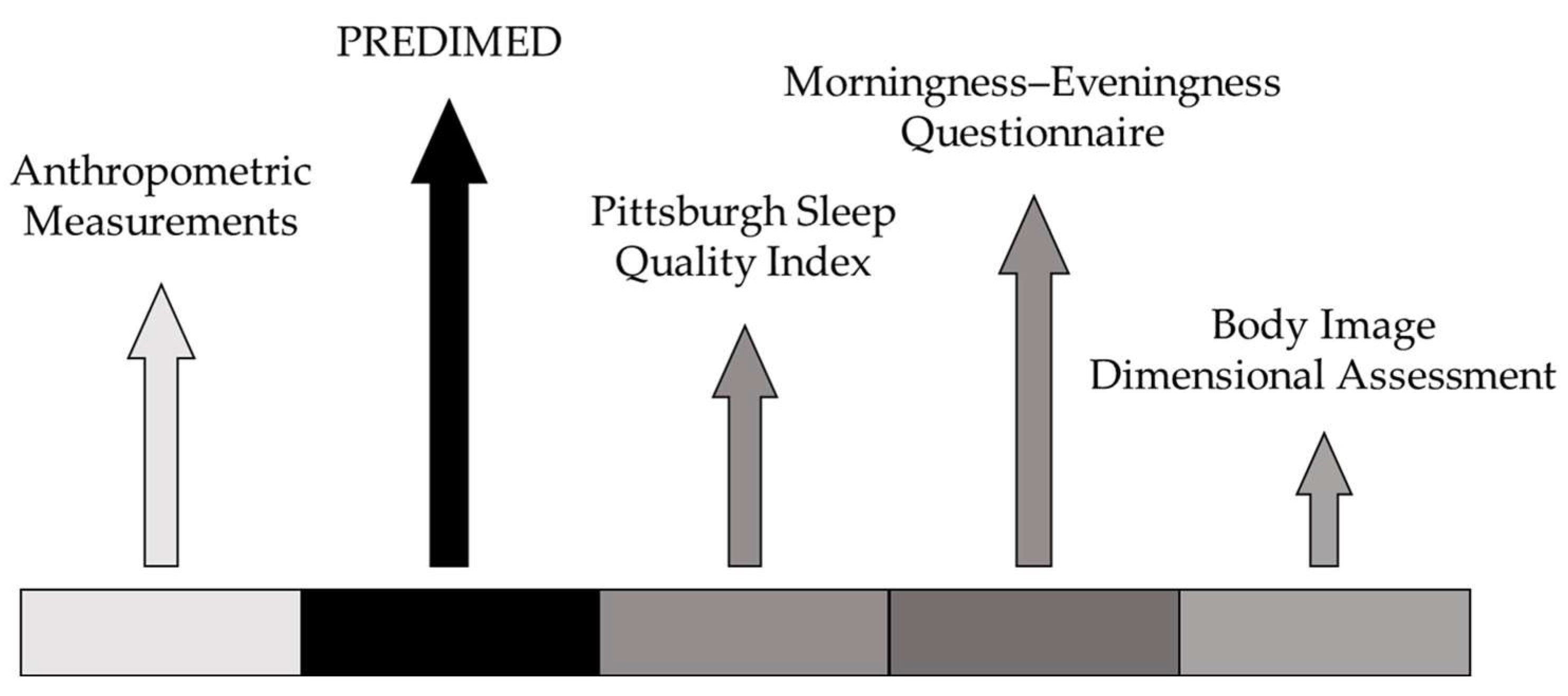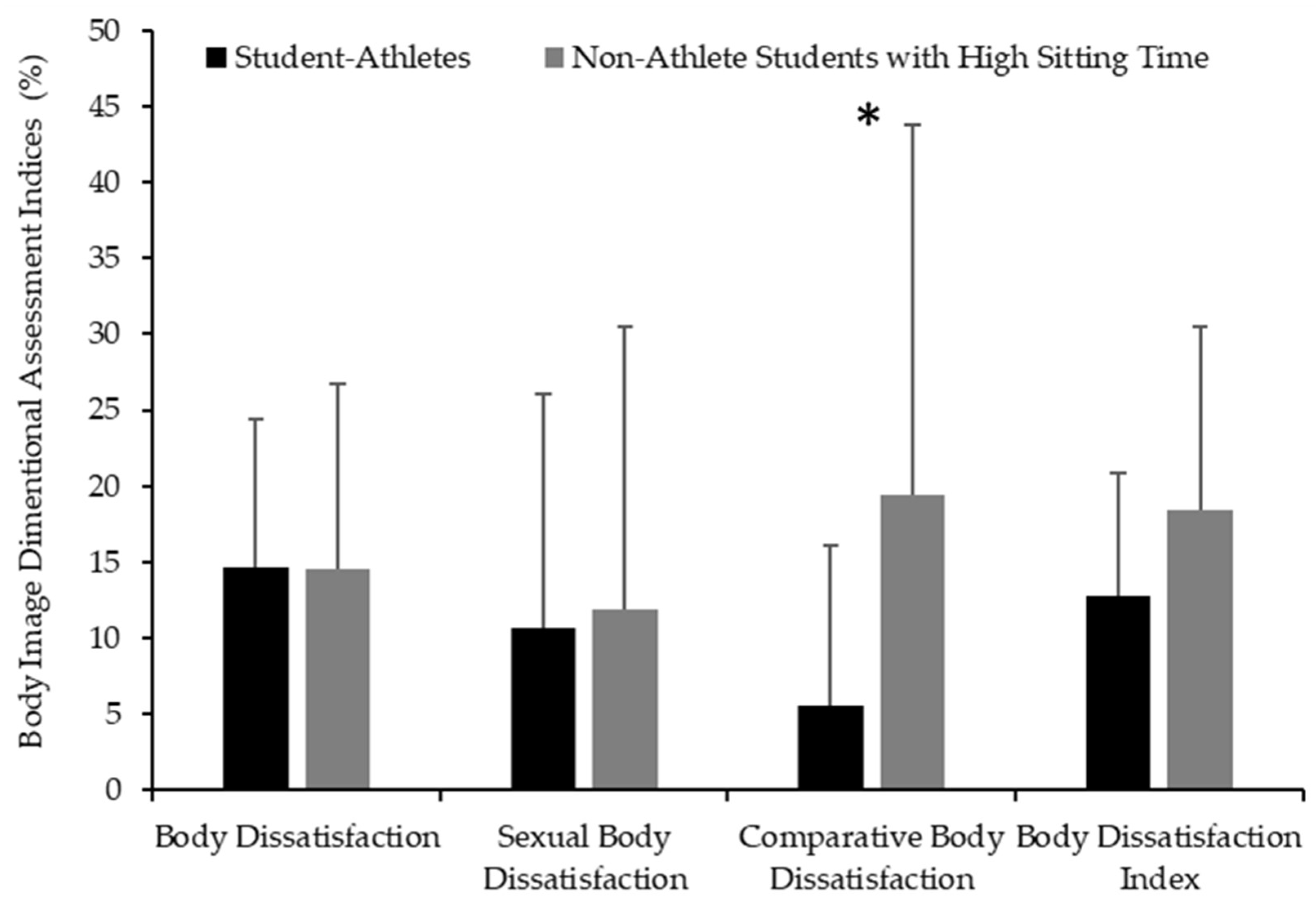Eating Right, Sleeping Tight? A Cross-Sectional Study on the Student-Athlete Paradox for Diet and Sleep Behaviors
Abstract
1. Introduction
2. Materials and Methods
2.1. Participants
2.2. Procedures
- Body Dissatisfaction (BD): The difference between perceived and ideal body images.
- Sexual Body Dissatisfaction (SxBD): The difference between perceived body shape and the shape deemed most attractive by the opposite sex.
- Comparative Body Dissatisfaction (CBD): The difference between perceived body image and peers’ typical shape.
2.3. Statistical Analysis
3. Results
4. Discussion
5. Clinical Implications
6. Conclusions
7. Limitations and Future Directions
Supplementary Materials
Author Contributions
Funding
Institutional Review Board Statement
Informed Consent Statement
Data Availability Statement
Conflicts of Interest
References
- Condello, G.; Capranica, L.; Doupona, M.; Varga, K.; Burk, V. Dual-Career through the Elite University Student-Athletes’ Lenses: The International FISU-EAS Survey. PLoS ONE 2019, 14, e0223278. [Google Scholar] [CrossRef] [PubMed]
- European Athletes as Student (EAS) Network European Athlete Student. The Dual Career Netrwork. Available online: https://www.dualcareer.eu (accessed on 3 September 2025).
- European Commission European Commission. Available online: https://commission.europa.eu/index_en (accessed on 3 September 2025).
- Stambulova, N.B.; Engström, C.; Franck, A.; Linnér, L.; Lindahl, K. Searching for an Optimal Balance: Dual Career Experiences of Swedish Adolescent Athletes. Psychol. Sport Exerc. 2015, 21, 4–14. [Google Scholar] [CrossRef]
- International Olympic Committee Gender Equality Through Time. Available online: https://www.olympics.com/ioc/gender-equality/gender-equality-through-time (accessed on 25 July 2025).
- FISU So Many Olympians Are Also Student-Athletes. Available online: https://www.fisu.net/2024/08/15/so-many-olympians-are-also-student-athletes/ (accessed on 25 July 2025).
- Paul, R.W.; Sonnier, J.H.; Johnson, E.E.; Hall, A.T.; Osman, A.; Connors, G.M.; Freedman, K.B.; Bishop, M.E. Inequalities in the Evaluation of Male Versus Female Athletes in Sports Medicine Research: A Systematic Review. Am. J. Sports Med. 2023, 51, 3335–3342. [Google Scholar] [CrossRef]
- Kegelaers, J.; Wylleman, P.; Defruyt, S.; Praet, L.; Stambulova, N.; Torregrossa, M.; Kenttä, G.; De Brandt, K. The Mental Health of Student-Athletes: A Systematic Scoping Review. Int. Rev. Sport Exerc. Psychol. 2024, 17, 848–881. [Google Scholar] [CrossRef]
- World Health Organization. Promoting Mental Health: Concepts, Emerging Evidence, Practice: A Report of the World Health Organization, Department of Mental Health and Substance Abuse in Collaboration with the Victorian Health Promotion Foundation and the University of Melbourne; World Health Organization: Geneva, Switzerland, 2005.
- Bull, F.C.; Al-Ansari, S.S.; Biddle, S.; Borodulin, K.; Buman, M.P.; Cardon, G.; Carty, C.; Chaput, J.-P.; Chastin, S.; Chou, R.; et al. World Health Organization 2020 Guidelines on Physical Activity and Sedentary Behaviour. Br. J. Sports Med. 2020, 54, 1451–1462. [Google Scholar] [CrossRef]
- McManama O’Brien, K.H.; Rowan, M.; Willoughby, K.; Griffith, K.; Christino, M.A. Psychological Resilience in Young Female Athletes. Int. J. Environ. Res. Public Health 2021, 18, 8668. [Google Scholar] [CrossRef]
- Kilpatrick, M.; Sanderson, K.; Blizzard, L.; Teale, B.; Venn, A. Cross-Sectional Associations between Sitting at Work and Psychological Distress: Reducing Sitting Time May Benefit Mental Health. Ment. Health Phys. Act. 2013, 6, 103–109. [Google Scholar] [CrossRef]
- Sempere-Rubio, N.; Aguas, M.; Faubel, R. Association between Chronotype, Physical Activity and Sedentary Behaviour: A Systematic Review. Int. J. Environ. Res. Public Health 2022, 19, 9646. [Google Scholar] [CrossRef]
- Mah, C.D.; Kezirian, E.J.; Marcello, B.M.; Dement, W.C. Poor Sleep Quality and Insufficient Sleep of a Collegiate Student-Athlete Population. Sleep Heath 2018, 4, 251–257. [Google Scholar] [CrossRef] [PubMed]
- Fatima, Y.; Doi, S.A.R.; Najman, J.M.; Al Mamun, A. Exploring Gender Difference in Sleep Quality of Young Adults: Findings from a Large Population Study. Clin. Med. Res. 2016, 14, 138–144. [Google Scholar] [CrossRef]
- Scheer, V.; Chandi, H.; Valero, E.; Thuany, M.; Knechtle, B.; Steinach, M. Sleep, Fatigue, and Recovery Profiles of the Longest Solo Unsupported One-Way Polar Ski Journey Across Antarctica. Int. J. Sports Physiol. Perform. 2024, 19, 1328–1333. [Google Scholar] [CrossRef] [PubMed]
- Brauer, A.A.; Athey, A.B.; Ross, M.J.; Grandner, M.A. Sleep and Health Among Collegiate Student Athletes. Chest 2019, 156, 1234–1245. [Google Scholar] [CrossRef]
- Chauvineau, M.; Hollville, E.; Duforez, F.; Guilhem, G.; Nedelec, M. Effect of a High-Heat-Capacity Mattress Topper on Sleep in Elite Badminton Players During a Summer Training Period: Does 1 Size Fit All? Int. J. Sports Physiol. Perform. 2025, 20, 1152–1160. [Google Scholar] [CrossRef]
- Litwic-Kaminska, K.; Kotysko, M. Sleep Quality of Student Athletes and Non-Athletes-the Role of Chronotype, Stress and Life Satisfaction. Sleep Sci. 2020, 13, 249–255. [Google Scholar] [CrossRef]
- Wills, C.; Ghani, S.; Tubbs, A.; Fernandez, F.-X.; Athey, A.; Turner, R.; Robbins, R.; Patterson, F.; Warlick, C.; Alfonso-Miller, P.; et al. Chronotype and Social Support among Student Athletes: Impact on Depressive Symptoms. Chronobiol. Int. 2021, 38, 1319–1329. [Google Scholar] [CrossRef]
- Heaney, S.; O’Connor, H.; Michael, S.; Gifford, J.; Naughton, G. Nutrition Knowledge in Athletes: A Systematic Review. Int. J. Sport Nutr. Exerc. Metab. 2011, 21, 248–261. [Google Scholar] [CrossRef]
- Peláez-Barrios, E.M.; Vernetta, M. Insatisfacción Corporal, Adherencia a La Dieta Mediterránea y Características Antropométricas En Gimnastas y Adolescentes Femeninas. Apunt. Educ. Física Deport. 2022, 149, 12–21. [Google Scholar] [CrossRef]
- Griffiths, A.; Matu, J.; Whyte, E.; Akin-Nibosun, P.; Clifford, T.; Stevenson, E.; Shannon, O.M. The Mediterranean Dietary Pattern for Optimising Health and Performance in Competitive Athletes: A Narrative Review. Br. J. Nutr. 2022, 128, 1285–1298. [Google Scholar] [CrossRef] [PubMed]
- You, Y.; Chen, Y.; Wei, M.; Tang, M.; Lu, Y.; Zhang, Q.; Cao, Q. Mediation Role of Recreational Physical Activity in the Relationship between the Dietary Intake of Live Microbes and the Systemic Immune-Inflammation Index: A Real-World Cross-Sectional Study. Nutrients 2024, 16, 777. [Google Scholar] [CrossRef]
- Doherty, R.; Madigan, S.; Warrington, G.; Ellis, J. Sleep and Nutrition Interactions: Implications for Athletes. Nutrients 2019, 11, 822. [Google Scholar] [CrossRef]
- Xanidis, N.; Brignell, C.M. The Association between the Use of Social Network Sites, Sleep Quality and Cognitive Function during the Day. Comput. Hum. Behav. 2016, 55, 121–126. [Google Scholar] [CrossRef]
- Beisecker, L.; Harrison, P.; Josephson, M.; DeFreese, J.D. Depression, Anxiety and Stress among Female Student-Athletes: A Systematic Review and Meta-Analysis. Br. J. Sports Med. 2024, 58, 278–285. [Google Scholar] [CrossRef]
- Thivel, D.; Tremblay, A.; Genin, P.M.; Panahi, S.; Rivière, D.; Duclos, M. Physical Activity, Inactivity, and Sedentary Behaviors: Definitions and Implications in Occupational Health. Front. Public Health 2018, 6, 288. [Google Scholar] [CrossRef]
- Festino, E.; Papale, O.; Di Rocco, F.; De Maio, M.; Cortis, C.; Fusco, A. Effect of Physical Activity Behaviors, Team Sports, and Sitting Time on Body Image and Exercise Dependence. Sports 2024, 12, 260. [Google Scholar] [CrossRef]
- Rubino, F.; Cummings, D.E.; Eckel, R.H.; Cohen, R.V.; Wilding, J.P.H.; Brown, W.A.; Stanford, F.C.; Batterham, R.L.; Farooqi, I.S.; Farpour-Lambert, N.J.; et al. Definition and Diagnostic Criteria of Clinical Obesity. Lancet Diabetes Endocrinol. 2025, 13, 221–262. [Google Scholar] [CrossRef] [PubMed]
- Riebe, D.; Ehrman, J.; Liguori, G. ACSM’s Guidelines for Exercise Testing and Prescription; Lippincott Williams & Wilkins: Philadelphia, PA, USA, 2021. [Google Scholar]
- Papale, O.; Festino, E.; Di Rocco, F.; Foster, C.; Prestanti, I.; Serafini, S.; Izzicupo, P.; Cortis, C.; Fusco, A. The Impact of a Multidimensional Physical Activity Intervention on Glycemic Control in Type 1 Diabetes: A Preliminary Study. J. Funct. Morphol. Kinesiol. 2025, 10, 163. [Google Scholar] [CrossRef] [PubMed]
- Anderson, T.; Galan-Lopez, N.; Taylor, L.; Post, E.G.; Finnoff, J.T.; Adams, W.M. Sleep Quality in Team USA Olympic and Paralympic Athletes. Int. J. Sports Physiol. Perform. 2024, 19, 383–392. [Google Scholar] [CrossRef]
- Zhu, M.; Cui, Z. Chronobiological Insights in Plyometric Jump Training: Optimizing Sport-Performance Adaptations for Volleyball Players. Int. J. Sports Physiol. Perform. 2024, 19, 1087–1096. [Google Scholar] [CrossRef]
- Condello, G.; Capranica, L.; Stager, J.; Forte, R.; Falbo, S.; Di Baldassarre, A.; Segura-Garcia, C.; Pesce, C. Physical Activity and Health Perception in Aging: Do Body Mass and Satisfaction Matter? A Three-Path Mediated Link. PLoS ONE 2016, 11, e0160805. [Google Scholar] [CrossRef]
- Mah, C.D.; Mah, K.E.; Kezirian, E.J.; Dement, W.C. The Effects of Sleep Extension on the Athletic Performance of Collegiate Basketball Players. Sleep 2011, 34, 943–950. [Google Scholar] [CrossRef] [PubMed]
- Juliff, L.E.; Halson, S.L.; Peiffer, J.J. Understanding Sleep Disturbance in Athletes Prior to Important Competitions. J. Sci. Med. Sport 2015, 18, 13–18. [Google Scholar] [CrossRef] [PubMed]
- Resza, A.M.; Hongwei, Y. Susilo Sleep Quality in University Student-Athletes: Influence of Chronotype, Excessive Daytime Sleepiness, and Stress. J. Phys. Educ. Sport 2024, 24, 1979–1985. [Google Scholar] [CrossRef]
- Vitale, J.A.; Weydahl, A. Chronotype, Physical Activity, and Sport Performance: A Systematic Review. Sport. Med. 2017, 47, 1859–1868. [Google Scholar] [CrossRef] [PubMed]
- St-Onge, M.P.; Mikic, A.; Pietrolungo, C.E. Effects of Diet on Sleep Quality. Adv. Nutr. 2016, 7, 938–949. [Google Scholar] [CrossRef]
- Steinfeldt, J.A.; Zakrajsek, R.A.; Bodey, K.J.; Middendorf, K.G.; Martin, S.B. Role of Uniforms in the Body Image of Female College Volleyball Players. Couns. Psychol. 2013, 41, 791–819. [Google Scholar] [CrossRef]
- Quittkat, H.L.; Hartmann, A.S.; Düsing, R.; Buhlmann, U.; Vocks, S. Body Dissatisfaction, Importance of Appearance, and Body Appreciation in Men and Women Over the Lifespan. Front. Psychiatry 2019, 10, 864. [Google Scholar] [CrossRef]
- Fusco, A.; MacDonncha, C.; Capranica, L.; Barat, C.; Bichi, A.; Blondel, L.; Daniel, R.; Doupona, M.; Figueiredo, A.J.; Keldorf, O.; et al. Dual Career in the Workplace: Co-Creation of a Conceptual Framework by Employers and Employee-Sportspersons Incorporating Corporate Social Responsibility and Brand Alignment. Front. Psychol. 2024, 15, 1432850. [Google Scholar] [CrossRef]





| Student-Athletes (n = 12) | Non-Athlete Students with High Sitting Time (n = 16) | Total (n = 28) | |
|---|---|---|---|
| Mean ± SD (Min–Max) | Mean ± SD (Min–Max) | Mean ± SD | |
| Age (years) | 21.6 ± 2.4 (19–26) | 24 ± 3.2 (20–32) | 23 ± 3.1 |
| Body Mass (kg) | 64.3 ± 8.1 (52–76) | 64 ± 8.2 (52–78) | 64.5 ± 8.1 |
| Body Height (cm) | 168 ± 7 (159–180) | 164 ± 5 (153–177) | 166 ± 6 |
| BMI (kg/m2) | 22.5 ± 2.3 (18.8–25.9) | 23.8 ± 2.8 (19.2–28.8) | 23.3 ± 2.6 |
Disclaimer/Publisher’s Note: The statements, opinions and data contained in all publications are solely those of the individual author(s) and contributor(s) and not of MDPI and/or the editor(s). MDPI and/or the editor(s) disclaim responsibility for any injury to people or property resulting from any ideas, methods, instructions or products referred to in the content. |
© 2025 by the authors. Licensee MDPI, Basel, Switzerland. This article is an open access article distributed under the terms and conditions of the Creative Commons Attribution (CC BY) license (https://creativecommons.org/licenses/by/4.0/).
Share and Cite
Papale, O.; Festino, E.; Di Rocco, F.; De Maio, M.; Foster, C.; Cortis, C.; Fusco, A. Eating Right, Sleeping Tight? A Cross-Sectional Study on the Student-Athlete Paradox for Diet and Sleep Behaviors. Nutrients 2025, 17, 2946. https://doi.org/10.3390/nu17182946
Papale O, Festino E, Di Rocco F, De Maio M, Foster C, Cortis C, Fusco A. Eating Right, Sleeping Tight? A Cross-Sectional Study on the Student-Athlete Paradox for Diet and Sleep Behaviors. Nutrients. 2025; 17(18):2946. https://doi.org/10.3390/nu17182946
Chicago/Turabian StylePapale, Olga, Emanuel Festino, Francesca Di Rocco, Marianna De Maio, Carl Foster, Cristina Cortis, and Andrea Fusco. 2025. "Eating Right, Sleeping Tight? A Cross-Sectional Study on the Student-Athlete Paradox for Diet and Sleep Behaviors" Nutrients 17, no. 18: 2946. https://doi.org/10.3390/nu17182946
APA StylePapale, O., Festino, E., Di Rocco, F., De Maio, M., Foster, C., Cortis, C., & Fusco, A. (2025). Eating Right, Sleeping Tight? A Cross-Sectional Study on the Student-Athlete Paradox for Diet and Sleep Behaviors. Nutrients, 17(18), 2946. https://doi.org/10.3390/nu17182946










